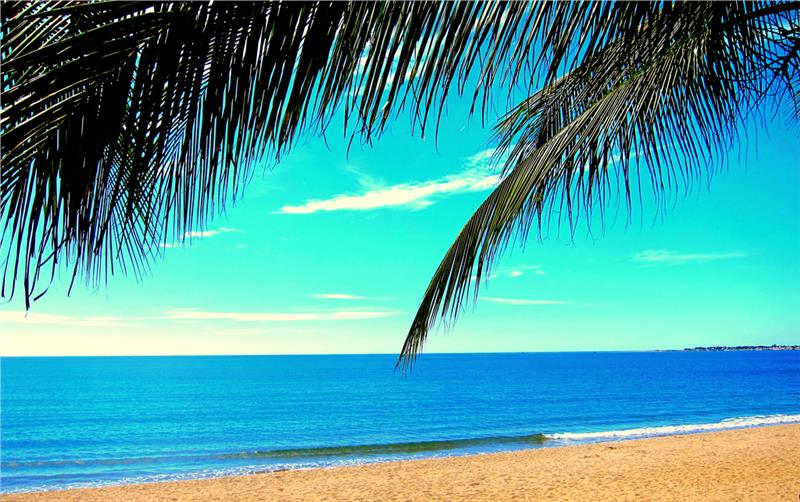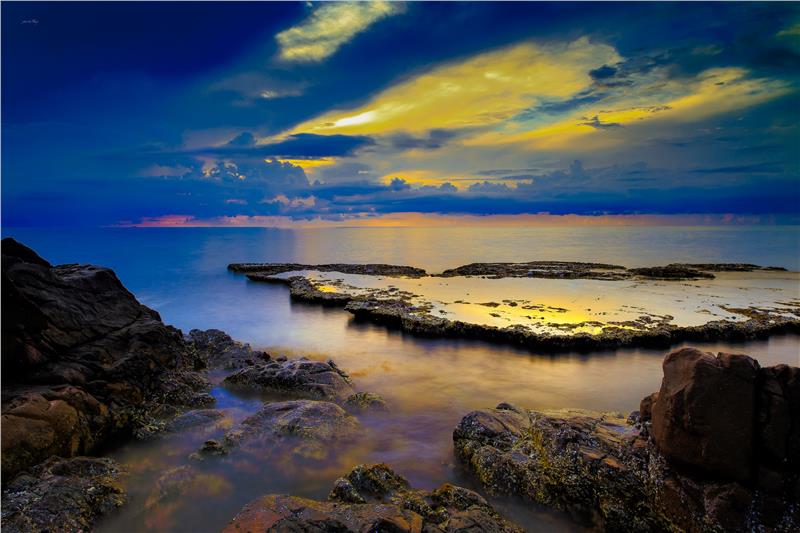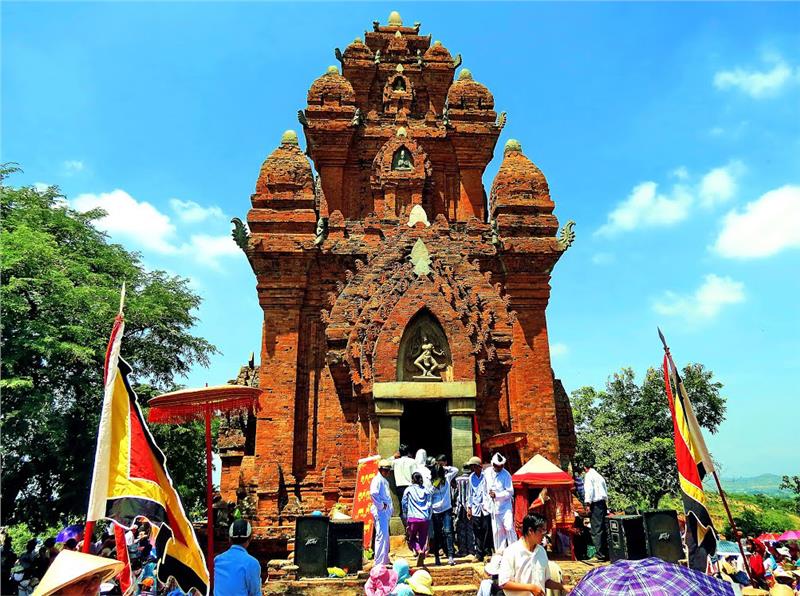Ninh Thuan is a province in Vietnam South Central Coast. The center of the province is Phan Rang city located 350km south of Ho Chi Minh City, 105km from Nha Trang, 110km from Dalat and 60km from Cam Ranh Airport, so it is very favorable for socio-economic development of the province. Archaeologists found in Nhon Hai, Ninh Thuan some ancient tombs with stone and bronze tools of Sa Huynh Culture dating back 2500 years ago. Ninh Thuan also keeps many valuable heritages of Cham culture including writing, folk songs, dances, costumes and brocade weaving, architecture and sculpture. The province has more than 20 villages of Cham people. Among them, many villages still maintain the custom of matriarchy. Ninh Thuan keeps nearly intact the system of Cham towers built centuries ago, typically Hoa Lai towers (Ba Thap) in the 9th century, Po Klong Garai in the 13th century and Po Rome in the 17th century.

Ninh Thuan is located in South Central Coast, between 11°18'14" and 12°09'15" north latitude, 108°09'08" and 109°14'25" east longitude, adjacent to Khanh Hoa in the north, Binh Thuan in the south, Lam Dong in the west and the South China Sea in the east. The natural area of the province is 3358 km2 with 7 administrative units. Ninh Thuan terrain is divided into 3 types including mountains, semi-mountain hill and coastal region. The mountain occupies 63.2% of the provincial area with the average height of 200 - 1000m. Semi-mountain hills accounts for 14.4% and the coastal region accounts for 22.4% of the natural area. Ninh Thuan located in the tropical monsoon climate. So, Ninh Thuan climate is divided into 2 distinct seasons: dry season and rainy season. The rainy season starts from September to November; the dry season lasts from December to September of next year. The annual average temperature is from 26 to 27°C, the average rainfall is 700-800mm.

On May 20th, 1901, Governor-General of French Indochina issued the Resolution to establish Phan Rang province. In 1913, Phan Rang province was erased, the north of the province was merged to Khanh Hoa, and the south of the province belonged to Binh Thuan. On July 5th, 1922, Phan Rang province or so-called Ninh Thuan province was re-established. In 1958, Ninh Thuan province consisted of 3 districts (24 communes): Thanh Hai (Khanh Hai district), An Phuoc (Hau Phuoc district), and Buu Son (An Son district). After April 30th, 1975, Ninh Thuan was merged to Binh Thuan, Tuyen Duc and Lam Dong into a new province of Thuan Lam. In February 1976, provinces of Ninh Thuan, Binh Thuan and Binh Tuy were merged into Thuan Hai province. On December 26th, 1991, Thuan Hai province was separated into Binh Thuan and Ninh Thuan. April 1st, 1992, Ninh Thuan was officially re-established and put into operation.
Ninh Thuan has 7 administrative units including Phan Rang-Thap Cham City, Bac Ai District, Ninh Hai District, Ninh Phuoc District, Ninh Son District, Thuan Bac District and Thuan Nam District.

Ninh Thuan population reaches nearly 569,000 people; the population density is 169 people/ km². The urban population reaches 205.200 people and the rural population is 716,400 people. In the province, there are 34 ethnic groups living together. Among them, Kinh ethnic group cover majority of population with 432,399 people. Cham people rank the second with 67,274 people, Raglai people rank the third with 58,911 people. Other ethnic groups consist of Co Ho, Hoa, Chu Ru, Nung, Tay, so on.

In 2014, Ninh Thuan economy grew relatively stably and had positive changes; the provincial gross domestic product increased significantly; scale production of sectors increased; budget revenue exceeded the plan; industrial production recovered and increased significantly. The production value increased 26.6%. Tourism activities have been maintained, sanitation and security in tourist areas are better, businesses has implemented various programs to promote and advertise to attract tourists, diversify products and improve quality of service. Post - telecommunication activities continue to be maintained and improved service quality. Public passenger transport service is maintained, the transport capacity is invested, better meet traveling demand and freight traffic. The export turnover was estimated at 55 million USD, falling 9.1% over the same previous. The total state budget revenue reached at 1700 billion dong, up 13.5% yoy and reached 13.3% of the yearly estimate. In addition, Ninh Thuan province has the largest growing grape area in the country, typically in districts of Ninh Phuoc and Thuan Nam.
The social welfare policies are implemented fully and promptly; the work of caring for the poor and beneficiaries is paid better attention; educational scale is maintained and quality of education has been raised. Disease prevention is proactive and effective. Security, political and social order and safety are maintained.

Ninh Thuan is a land with many distinctive cultures. Among them, Cham culture is the most excellent contributing to the diversity of Vietnamese culture in general and ethnic culture of Ninh Thuan in particular. Located in South Central Vietnam, during the period of ancient Champa Kingdom, Ninh Thuan and Binh Thuan belonged to Panduranga district of Champa. Particularly, Ninh Thuan is one of the residences of the ancient Vietnamese. Archaeologists found in Nhon Hai, Ninh Thuan the ancient tombs buried with stone, ironwork of Sa Huynh civilization about 2500 years ago. Additionally, Ninh Thuan still preserves the precious heritages of the Cham culture, including writing, folk songs and dances, costumes and brocade weaving, architecture and sculpture.
Cham people in Ninh Thuan are known for many traditional crafts. However, over the time, traditional crafts are gradually diminished, until now, there are some pottery villages, brocade weaving villages and traditional medicinal profession is preserved and developed. Three traditional villages of Cham people officially recognized includ My Nghiep, Chung My and Bau Truc pottery village. Brocade weaving and pottery of Cham people in Ninh Thuan bear their own identities. Brocade weaving retains many traditional features, especially brocade products with the characteristic pattern and colors woven by long looms (Jih Dalah). Products of Cham people in Ninh Thuan are very rich, diverse and very popular in the market, especially the tourism market. But they are not only the value of commodities but also the cultural products bearing its own identity, the message with valuable space and time in the process of exchanges and development.

Located in the South Central Coast, Ninh Thuan has the most Cham people in the country. So when arriving here, tourists seem to be entered a new world, full of attraction with the architectural works of the ancient Champa Kingdom, of which the most notably works are three clusters Hoa Lai, Po Klong Garai and Po Rome. Po Klong Garai is the common name for the most majestic and beautiful cluster of Cham towers in Vietnam in Phan Rang. The tower was built in the late 13th century and the early 14th century in Doi Trau hill, Do Vinh ward. The main tower is 20.5 meters in height and has many floors. Behind the main tower is a temple in which princess Kut, also known as To Ly, is worshiped. The second tower is 8.56 meters in height. This tower has the same shape as the main one. In the south of the two towers is another tower called “Fire god” which is 9.31 meters high. Mysterious beauty with nostalgia of each tower always leaves a lasting impression on tourists.
Besides the unique architectural works, traditional villages are also attractions in Ninh Thuan. Bau Truc pottery village is one of them. Located along National Route 1A, in Ninh Phuoc district, Bau Truc is considered as one of the oldest pottery villages in South East Asia. Next to Bau Truc village is My Nghiep village with the traditional brocade weaving reflecting the panoramic view of Cham people's lives. Situated in Vinh Hy Village, Vinh Hai Commune, Ninh Hai District, about 42 kilometers away from the center of Phan Rang City, Vinh Hy Bay is evaluated as one of the most beautiful bays in Vietnam along with Halong Bay (Quang Ninh), Van Phong Bay and Cam Ranh Bay (Khanh Hoa). Vinh Hy Bay is the center connecting the ecology of Nui Chua National Park including many branched of river and streams following the sea, smooth white sandy beaches, blue water and attractions as Lo O stream, Ba Dien beach, Ca Tien, Coc beach, etc. With the outstanding value of topography, terrain, climate and high biological diversity, rich flora and fauna, Vinh Hy Bay is an ideal attraction of tourists who love to explore the sea and vast nature. Interestingly, coming to Thai An grape garden, tourists will have the opportunity to explore and learn how to grow grape, process products from grapes as grape wine or grape jam.
Festival

Besides tangible cultural values, intangible culture of Cham people in Ninh Thuan is very vibrant with more than 100 festivals held year round, especially Kate festival which is held in the 7th lunar month. This is the most unique folk festivals in the cultural treasure of Cham people reflecting the activities of local community. The festival is an occasion for them to commemorate the Goddess Po Nagar who founded the Cham nation and taught the old Cham people how to wet rice and cotton trees. Additionally, there are numerous exciting festivals in Ninh Thuan await tourists to explore as Chabun festival, Lamuwan festival, fishing festival, Ponai Tang festival and so on.
